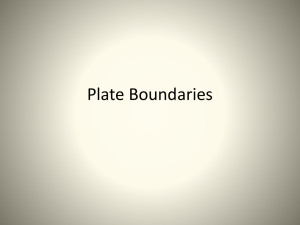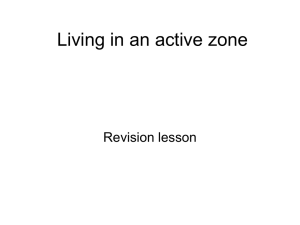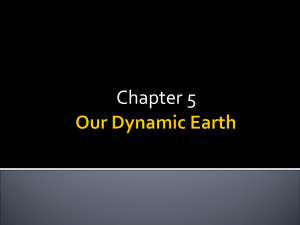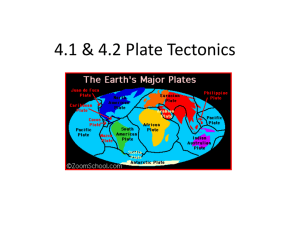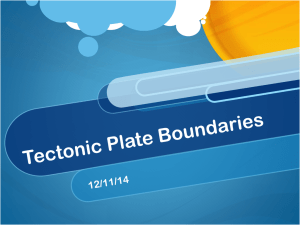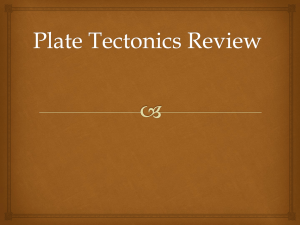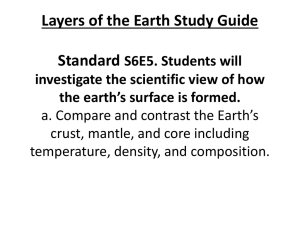Plate Margins
advertisement
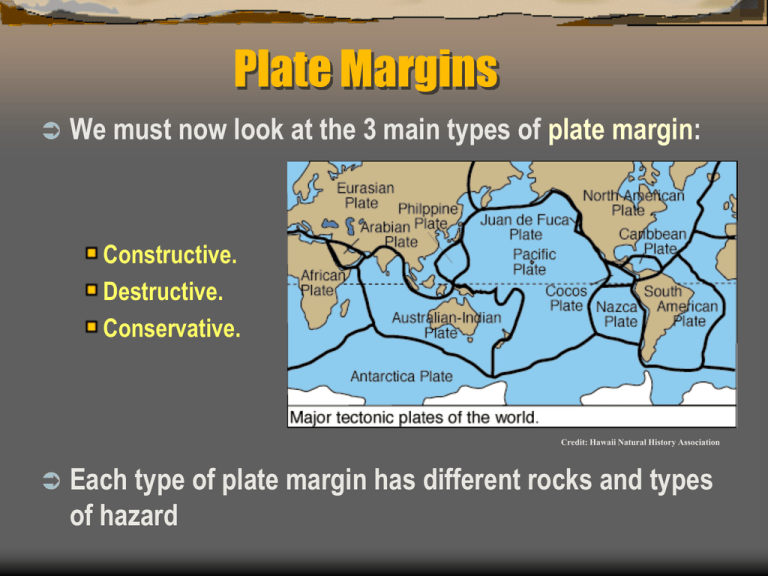
Plate Margins We must now look at the 3 main types of plate margin: Constructive. Destructive. Conservative. Credit: Hawaii Natural History Association Each type of plate margin has different rocks and types of hazard Plate Margins Credit: U.S. Geological Survey Destructive Plate Margins May also be called convergent plate margins. Why? What makes them converge? There are 3 types of destructive plate margins depending on what types of plate are involved: Credit: Hawaii Natural History Association Oceanic v oceanic Oceanic v continental Continental v continental Each will produce different hazards and rocks. Golden Rule 1 Why do plates/rocks melt: 1. Because the temperature has increased. 2. Because the pressure is decreased. 3. Because it is saturated in water. If one or more of these situations exists then the plate/rock will melt. Golden Rule 2 What kind of magma is produced when a plate/rock melts? Remember how we classify igneous rocks. Acid: > 66% quartz rich Intermediate: 52 – 66 % Basic: 44 – 52% quartz poor Ultrabasic: < 44% Quartz is one of the first minerals to melt, so When the initial magma melts the one it produces will be richer in SiO2 and so will move towards the acid end of the scale. If you melt an ultrabasic rock it will produce a basic magma. If you melt a basic rock the magma will be more intermediate. Golden Rule 3 The more SiO2 in a magma the more explosive will be the volcanic eruptions. Why? Because the magmas are more viscous/sticky. Gasses come out of solution when a magma reaches the surface (P drops) but they cannot escape easily. They therefore expand putting pressure on the magma chamber. Eventually the P is so great that the top/plug is blown off or the side slips and a violent eruption occurs. Oceanic v Oceanic collision Credit: U.S. Geological Survey Oceanic v Oceanic collision The features/landforms: Subduction zone: describes the whole area where subduction is taking place. Ocean Trench: is the deep valley formed in the ocean floor as the subducted plate bends. Benioff zone: zone of earthquakes set off by the solid lithospheric plate forcing it’s way through the mantle. Island Arc: An arc of islands running parallel to the trench/subduction zone created by volcanic activity fed by magma from the melting subducted plate. Oceanic v Oceanic 2 The processes: Subduction: Occurs where a piece of oceanic lithosphere bends and sinks beneath another plate. – Why do oceanic plates subduct? – Because oceanic crust is denser (3.0). Credit: U.S Geological Survey Oceanic v Oceanic 3 Seismic activity: As the cold/solid oceanic plate sinks through the mantle there is frictional resistance. When the resistance is overcome and the plate moves the energy is released as seismic waves = earthquake. This is the Benioff zone. Credit: U.S. Geological Survey Oceanic v Oceanic 4 Melting: As mentioned earlier there are 3 reasons why crust may melt. Which is occurring in this situation? – Increased T as the plate sinks deeper. – Also the plate is saturated in water. The melting oceanic crust is basic so what kind of magma will form when it melts? More SiO2 rich and so will move towards being intermediate. This magma will move upwards through the overlying mantle and thin crust to the surface. Credit: U.S. Geological Survey Oceanic v Oceanic 5 Explosive volcanic activity. Basic/intermediate magma will be fairly violent. Enough volcanic activity will occur to build volcanic islands above sea level in an arc parallel to the plate margin (island arc). Credit: U.S. Geological Survey Oceanic v Oceanic examples Credit: U.S. Geological Survey Montserrat/Caribbean arc: Soufriere Hills. Aleutian islands. Indonesia: Krakatoa Philippines: Pinatubo Kamchatka. Oceanic v Continental Crust collision The features/landforms: Many are the same: Trench. Subduction zone. Benioff zone Continent based volcanoes. Fold mountains. Credit: Hawaii Natural History Association Oceanic v Continental Crust 2 The processes. Again very similar to ocean v ocean with a subtle difference. Subduction (but only the oceanic crust will subduct). Seismic activity. Melting: Mountain building (orogenesis) Credit: Hawaii Natural History Association Oceanic v Continental Crust 3 What happens to the melt as it enters the continental crust? Remember that the magma is now intermediate(ish). It travels up through the continental crust that has what composition? Acid. The hot magma melts the continental crust and adds SiO2 rich crust to the intermediate magma to make magma that is very intermediate or acid. Credit: U.S. Geological Survey Oceanic v Continental Crust 4 Acid/intermediate magma will produce what kind of volcanic activity? Very explosive and dangerous. Mountain building (orogenesis). This involves crust being compressed and either folding or faulting. Fault movement sets off earthquakes. There will therefore be earthquakes linked to both the Benioff zone and orogenesis. Credit: U.S. Geological Survey Oceanic v Continental Examples Volcanoes along the Andes: Eruptions of Mt. St. Helens, Popacatapetl (Mexico) Nevada del Ruiz (Columbia) The Rockies/Cordillera: Credit:/ U.S. Geological Survey Mt. St. Helens Credit:/ U.S. Geological Survey Continental v Continental Crust Credit: U.S. Geological Survey Credit: U.S. Geological Survey Continental v Continental Crust The features/landforms. Mountain ranges Everest The processes: Mountain building (orogenesis). No subduction because continental crust will not subduct. Credit: U.S. Geological Survey Continental v Continental Crust Will there be volcanoes? The crust is up to 90 km thick and so is hot enough at it’s base to melt. However, the melt produced is so viscous and the distance to the surface so far that magma will not make it to the surface. Therefore NO VOLCANOES. Credit: U.S. Geological Survey Continental v Continental Crust Will there be earthquakes? Orogenesis is still taking place. All the energy is being put into deforming the rocks. So YES there will be many large earthquakes. Conservative Plate Margins This is where 2 plates are sliding past each other horizontally but are not being created or destroyed. There is only one really good example in the world: California, San Andreas Fault. Credit: U.S. Geological Survey (Photographer – Robert E Wallace Credit: U.S. Geological Survey Conservative Plate Margin What kind of volcanic activity will there be? None. Why not? Nothing is melting. Will there be any earthquakes? Yes and very large. Credit: U.S. Geological Survey Constructive Plate Margin Credit: U.S. Geological Survey May also be called: divergent plate margins. Why? New crust is generated along ocean ridges. Examples are: The Mid Atlantic Ridge and the East Pacific Rise. Constructive Plate Margin Credit: U.S. Geological Survey Along conservative margins there is neither a loss nor a gain and the plates slip past each other, these margins are marked by transfo Constructive Plate Margin Credit: U.S. Geological Survey Mid ocean ridges are characterised by: •Active volcanoes (submarine volcanoes and in places emergent volcanic islands) •Small earthquakes •Lack of sediment •High heat flow Constructive Plate Margin The new crust formed at this plate margin, along with a layer of the upper most part of the mantle, moves away from the ridge and new material is added to the trailing edge. Credit: U.S. Geological Survey Constructive Plate Margin Iceland forms example of Mid Ocean Ridge that has grown into a volcanic complex above sea level Credit: U.S. Geological Survey Passive Plate Margins Credit: Hawaii Natural History Association Nothing is happening. 2 pieces of crust are fused together. Like the N. American continental plate and the Atlantic oceanic plate. However, in time the margin may become active. It is already starting to subduct in the Caribbean arc region (Montserrat).

